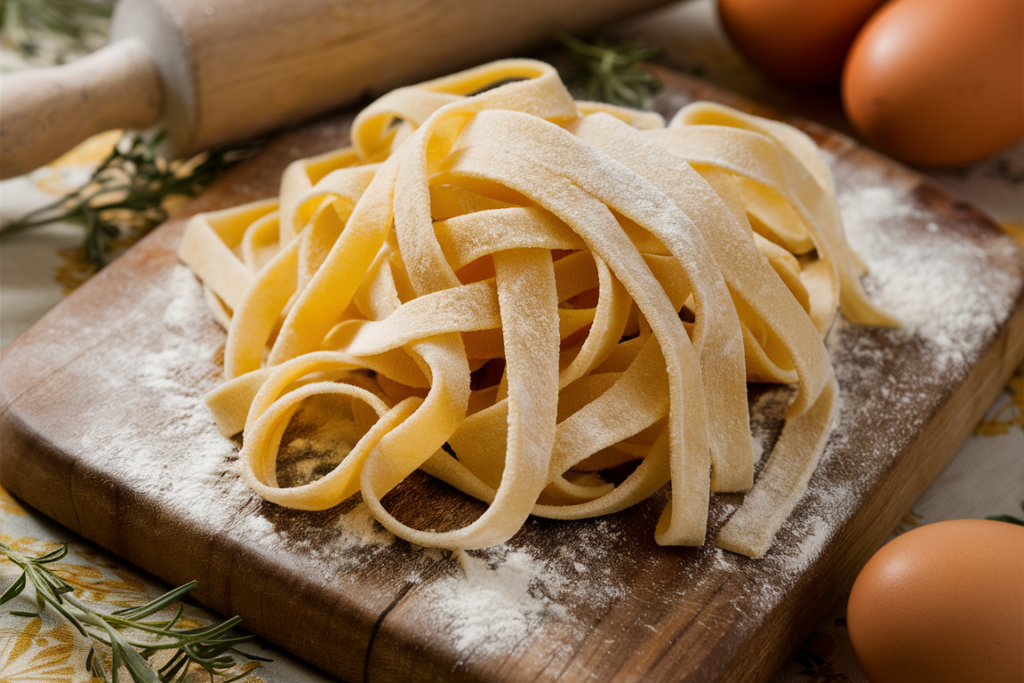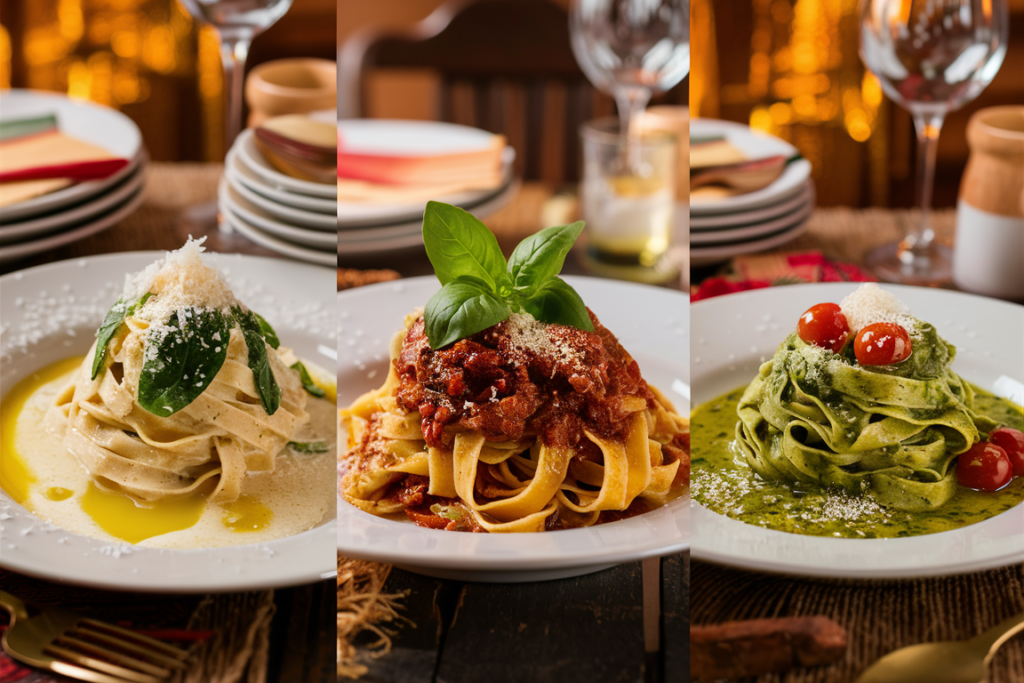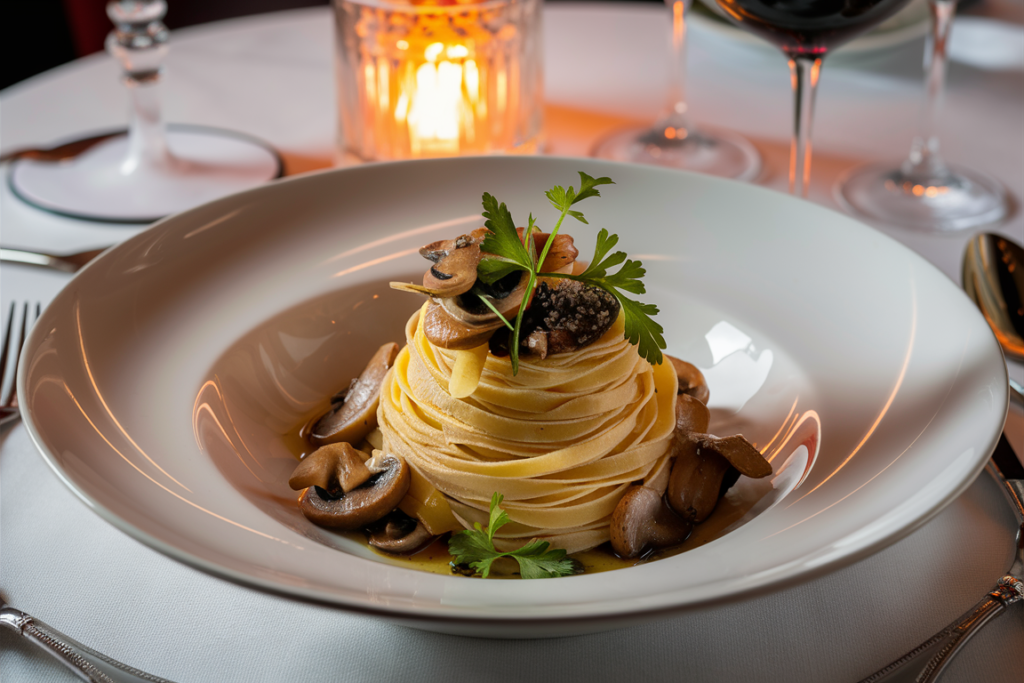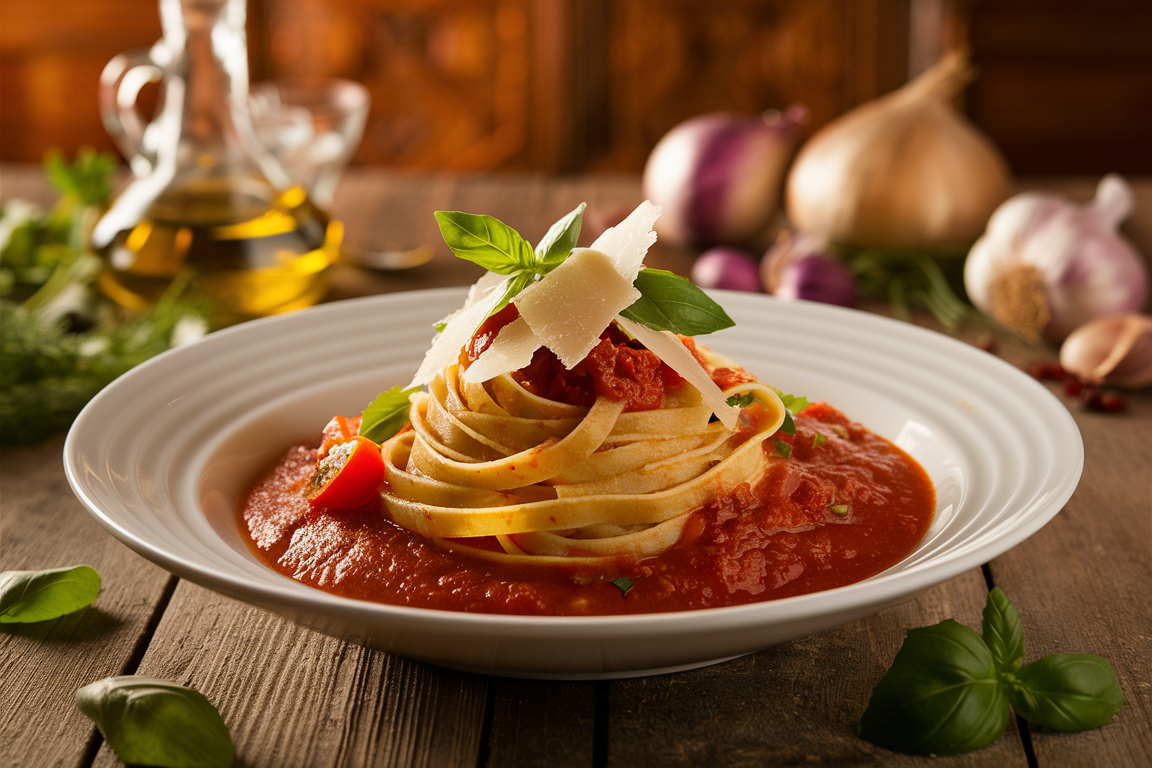Part 1: Introduction and Basics of Tagliatelle
Introduction to Tagliatelle
Tagliatelle is more than just another type of pasta—it’s an iconic symbol of Italian culinary excellence. Whether served with rich, meaty sauces or light, herby toppings, tagliatelle has carved a niche in global cuisine. Its unique shape, texture, and versatility make it a popular choice for pasta lovers everywhere.
In this article, we’ll explore the history, nutritional value, and cultural significance of tagliatelle, providing you with a comprehensive understanding of this beloved dish.

What Is Tagliatelle?
Tagliatelle is a type of ribbon-shaped pasta originating from Italy. Notably, it is known for its flat, broad structure, which makes it ideal for pairing with a variety of sauces. Typically, it is made from a simple combination of flour and eggs, emphasizing its traditional and wholesome nature. In fact, the pasta’s name derives from the Italian word “tagliare,” which means “to cut,” thereby reflecting the traditional hand-cutting method used to achieve its long, elegant strands.
History and Origins of Tagliatelle
Dating back to the Emilia-Romagna and Marche regions of Italy, tagliatelle carries a rich culinary heritage. Interestingly, legend has it that the pasta was created as a tribute to Lucrezia Borgia, with its shape inspired by her long, golden hair. Regardless of whether this romantic tale holds true, the historical significance of tagliatelle remains undeniable. After all, it is deeply rooted in Italian gastronomy and continues to be a symbol of tradition and cultural pride.
Characteristics of Tagliatelle Pasta
Tagliatelle stands out due to its:
- Width: Approximately 6–8 millimeters wide, providing a hearty bite.
- Texture: Smooth yet slightly rough, allowing sauces to cling beautifully.
- Structure: Thick enough to hold heavier sauces like ragù while maintaining a delicate mouthfeel.
Tagliatelle vs. Other Types of Pasta
Unlike thinner pastas like spaghetti or capellini, tagliatelle is broader and pairs perfectly with robust, chunky sauces. Its shape also distinguishes it from fettuccine, which is similar but narrower. These subtle differences highlight the culinary specificity of tagliatelle, making it a standout option.
Nutritional Value of Tagliatelle
Common Ingredients in Tagliatelle Dough
Traditional tagliatelle dough is made with all-purpose flour, semolina flour, and fresh eggs. These simple ingredients create a nutritious base. Per serving, tagliatelle provides:
- Carbohydrates: A steady source of energy.
- Protein: Eggs contribute to its higher protein content.
- Micronutrients: Including selenium, B vitamins, and iron.
For those seeking a healthier alternative, whole-grain or gluten-free options are widely available.
Benefits of Choosing Tagliatelle for Meals
Tagliatelle offers several benefits:
- Adaptability: Compatible with meat, vegetarian, or vegan recipes.
- Satiety: Its dense texture makes for satisfying meals.
- Cultural richness: Cooking tagliatelle brings an authentic taste of Italy to your kitchen.
Why Is Tagliatelle a Popular Choice?
Versatility in Recipes
One of tagliatelle’s greatest strengths is its adaptability. Whether paired with hearty Bolognese or a light pesto sauce, it delivers exceptional flavor. Seasonal ingredients, from mushrooms to asparagus, can further enhance its taste.
Tradition and Cultural Significance
In Italy, making tagliatelle is often a family affair, with recipes passed down through generations. It’s celebrated during regional festivals and featured prominently in holiday feasts. Choosing tagliatelle is not just about enjoying delicious food—it’s about connecting with Italian heritage.
FAQs:
- What makes tagliatelle unique?
Its flat, ribbon-like shape and ability to hold sauces set it apart. - How is it traditionally prepared?
With a dough of flour and eggs, rolled out thin and hand-cut. - What is the best sauce for tagliatelle?
Ragù alla Bolognese is a classic pairing. - Can I make gluten-free tagliatelle?
Yes, gluten-free flours like rice or chickpea flour work well. - Is tagliatelle healthier than spaghetti?
Both are similar nutritionally, but whole-grain versions of tagliatelle offer more fiber. - What’s the ideal thickness for tagliatelle?
1–2 mm, ensuring it cooks evenly without becoming mushy. - Can tagliatelle be frozen?
Fresh tagliatelle freezes well for up to three months. - What regions in Italy are famous for tagliatelle?
Emilia-Romagna and Marche are renowned for this pasta. - Can I use tagliatelle for desserts?
While uncommon, it can be used in sweet baked pasta dishes. - Is homemade tagliatelle better than store-bought?
Homemade versions offer fresher flavor and texture.
Part 2: Culinary Uses of Tagliatelle
Best Recipes Featuring Tagliatelle
Tagliatelle’s wide, flat ribbons are a culinary canvas, making them perfect for showcasing a variety of recipes. From hearty meat sauces to creamy vegetarian dishes, this pasta adapts effortlessly to different flavors and textures. As a result, the versatility of tagliatelle makes it a favorite in kitchens worldwide.

Classic Sauces for Tagliatelle
The sauce makes the dish, and therefore, tagliatelle’s texture ensures it pairs beautifully with a range of classic Italian sauces. For this reason, let’s explore a few signature recipes that highlight the true essence of tagliatelle.
Tagliatelle Bolognese
A quintessential pairing, Tagliatelle Bolognese originates from Bologna, Italy. The sauce combines:
- Ground meat (usually beef or pork).
- Tomato paste.
- Aromatic vegetables like onions, carrots, and celery.
- A splash of red wine.
Slow-cooked to perfection, this robust dish is a testament to the harmony of flavors that tagliatelle can deliver. For a deeper dive into Bolognese sauce preparation, check out this step-by-step guide.
Tagliatelle Alfredo
Although traditionally associated with fettuccine, Alfredo sauce works equally well with tagliatelle. Made with:
- Butter.
- Cream.
- Parmesan cheese.
This dish offers a luxurious creaminess that complements the pasta’s tender texture.
Tagliatelle Carbonara
A Roman classic, carbonara combines:
- Guanciale (cured pork cheek).
- Egg yolks.
- Pecorino Romano cheese.
Its creamy yet light flavor profile makes it an excellent choice for tagliatelle. The pasta’s width ensures every bite is rich and satisfying.
Tagliatelle in Italian Cuisine
Tagliatelle occupies a central place in Italian culinary traditions. In fact, each region brings its unique touch, thereby creating an array of dishes that celebrate local ingredients and cooking styles. As a result, tagliatelle has become a symbol of regional diversity within Italian cuisine.
Traditional Italian Dishes with Tagliatelle
From Emilia-Romagna’s Ragù alla Bolognese to Veneto’s Duck Ragù, tagliatelle adapts to regional flavors. It’s also served with:
- Wild mushroom sauces, especially in northern Italy.
- Truffle shavings for a luxurious twist.
Seasonal Recipes Using Tagliatelle
Tagliatelle shines in seasonal cooking, effortlessly showcasing fresh produce throughout the year:
- Spring: For a light, zesty flavor, pair tagliatelle with asparagus and lemon zest. This combination adds a vibrant touch to your dish.
- Summer: Meanwhile, cherry tomatoes and basil offer a refreshing twist, perfect for warm-weather meals.
- Autumn: As the weather cools, butternut squash and sage create a comforting, hearty meal.
- Winter: Finally, tagliatelle pairs beautifully with hearty stews and game meats, providing a satisfying dish for colder days.
Pairing Tagliatelle with Ingredients
Pairing the right ingredients with tagliatelle enhances its natural richness. Whether you’re creating a simple weekday dinner or a gourmet feast, the following combinations will elevate your dish.
Protein Pairings for Tagliatelle
Proteins add depth and balance to tagliatelle dishes. Consider pairing with:
- Meats: Braised beef, pork belly, or lamb ragù.
- Seafood: Shrimp, scallops, or lobster for a sophisticated touch.
- Plant-based options: Lentils, tofu, or mushrooms for vegetarian alternatives.
Vegetables That Complement Tagliatelle
Fresh vegetables bring color and texture to tagliatelle recipes. Popular choices include:
- Zucchini: Adds a subtle sweetness.
- Spinach: Balances heavier sauces.
- Peppers: Introduce a hint of crunch and natural sweetness.
Herbs and Spices for Enhancing Flavor
Herbs and spices can transform tagliatelle into a flavorful masterpiece. Consider:
- Basil and oregano for Italian authenticity.
- Parsley and sage for earthy undertones.
- Chili flakes for a spicy kick.
FAQs:
- What’s the best protein for tagliatelle?
Braised meats like beef and pork work exceptionally well. - Can seafood pair with tagliatelle?
Yes, shrimp and scallops are excellent choices. - What are some vegetarian tagliatelle recipes?
Try it with spinach, cherry tomatoes, or roasted vegetables. - Are there gluten-free tagliatelle recipes?
Yes, use gluten-free flours like rice or almond flour. - What herbs work best with tagliatelle?
Basil, oregano, and sage enhance its flavor. - Can I use truffles with tagliatelle?
Absolutely! Truffles add an earthy, luxurious flavor. - What seasonal ingredients pair well with tagliatelle?
Spring vegetables like asparagus or autumn flavors like squash work wonderfully. - How do I make creamy tagliatelle dishes lighter?
Use Greek yogurt or low-fat cream as substitutes. - What spices can I use to enhance tagliatelle?
Chili flakes, nutmeg, and black pepper are excellent options. - What oils work best with tagliatelle?
Extra virgin olive oil and truffle oil are ideal for dressing.
Part 3: Preparing and Serving Tagliatelle
How to Cook Tagliatelle Perfectly
Achieving the perfect texture and flavor when cooking tagliatelle requires attention to detail and a few expert tips. Whether using fresh or dried pasta, preparation is key to bringing out the best in your dish.

Boiling and Al Dente Cooking Tips
Cooking tagliatelle to perfection begins with boiling. To start, here are the steps to ensure you achieve the ideal al dente texture:
- Use Plenty of Water: Boil at least 1 liter of water for every 100 grams of pasta.
- Add Salt Generously: Season the water once it reaches a rolling boil. Aim for the taste of seawater—it enhances the pasta’s flavor.
- Stir Immediately: Prevent clumping by stirring the pasta right after adding it to the pot.
- Monitor Cooking Time:
- Fresh tagliatelle cooks in 2–3 minutes.
- Dried tagliatelle takes 8–10 minutes.
- Taste Test: Check for firmness just before the recommended cooking time ends.
Tips for Fresh vs. Dried Tagliatelle
The type of tagliatelle you use impacts its preparation:
- Fresh Tagliatelle: Best for sauces that emphasize delicate flavors, such as herb butter or cream sauces. Requires gentle handling to prevent breaking.
- Dried Tagliatelle: Works well with robust sauces like Bolognese. Its sturdier texture absorbs rich flavors beautifully.
Common Mistakes When Cooking Tagliatelle
Avoid these common pitfalls:
- Underseasoning Water: To begin with, always salt generously. Otherwise, unsalted water results in bland pasta, diminishing the overall flavor.
- Overcooking: Tagliatelle becomes mushy if cooked too long. Therefore, it’s essential to stick to al dente for the perfect texture.
- Skipping Sauce Tossing: Moreover, tossing pasta with sauce ensures even coating and flavor infusion, which enhances the dish’s overall appeal.
Creative Serving Ideas for Tagliatelle
Once your tagliatelle is perfectly cooked, presentation becomes the next step. Elevating the dish with creative plating or fusion-inspired approaches enhances both aesthetics and taste.
Plating Techniques for Elegant Presentation
Create a restaurant-quality dish at home with these plating tips:
- Twist and Stack: Use a carving fork to twirl the pasta into a neat bundle before placing it on the plate.
- Garnish Thoughtfully: Add fresh herbs, grated cheese, or a drizzle of olive oil for a polished finish.
- Use Wide Bowls: Highlight the pasta’s long ribbons and sauce without overcrowding.
Tagliatelle in Fusion Cuisines
While traditionally Italian, tagliatelle adapts well to international flavors:
- Asian Fusion: For a creative twist, use soy sauce, sesame oil, and stir-fried vegetables to transform tagliatelle into a flavorful noodle stir-fry.
- Mexican Flair: Alternatively, toss tagliatelle with chipotle sauce, and top it with cilantro and avocado for a bold, zesty flavor.
- French Influence: For an elegant option, pair tagliatelle with a creamy mushroom and thyme sauce, creating a rich and sophisticated dish.
Storing and Reheating Tagliatelle
Proper storage and reheating are essential to maintain the quality and flavor of tagliatelle, whether fresh or cooked.
Best Practices for Storing Fresh Pasta
If you’ve made or purchased fresh tagliatelle, follow these guidelines:
- Refrigeration: Store in an airtight container for up to 2 days.
- Freezing: Dust the pasta lightly with flour, coil into nests, and freeze in an airtight bag. It lasts up to 3 months.
Reheating Techniques to Maintain Flavor
To avoid dry or sticky pasta, use these reheating methods:
- Stovetop: Toss pasta with a small amount of sauce or olive oil in a skillet over low heat.
- Boiling Water: For plain pasta, immerse in boiling water for 30–60 seconds.
- Microwave (Last Resort): Add a splash of water or sauce, cover with a damp paper towel, and heat in short intervals.
Conclusion: Why Tagliatelle Is a Culinary Favorite
Tagliatelle embodies the best of Italian cuisine—simplicity, versatility, and rich tradition. Moreover, its ability to pair with diverse flavors and adapt to various cooking techniques makes it a staple in kitchens worldwide. As such, it continues to be cherished by chefs and home cooks alike. Whether you’re a seasoned chef or a home cook, incorporating tagliatelle into your repertoire ensures endless possibilities for creating satisfying and memorable meals.
FAQs:
- What is the best way to store fresh tagliatelle?
Refrigerate for up to 2 days or freeze for longer storage. - How can I reheat tagliatelle without it drying out?
Reheat on the stovetop with added sauce or in boiling water for a quick refresh. - What is the most creative way to serve tagliatelle?
Twist into nests, garnish elegantly, and experiment with fusion cuisines. - Can I use tagliatelle in cold pasta dishes?
Yes, it works well in salads with light dressings and fresh vegetables. - What’s the best sauce for reheated tagliatelle?
A light olive oil or butter-based sauce prevents stickiness. - Can I make tagliatelle vegan?
Yes, substitute eggs with water or plant-based alternatives like flaxseed gel. - How do I avoid clumping when cooking tagliatelle?
Stir immediately after adding to the pot and use ample water. - What kind of cheese pairs well with tagliatelle?
Parmigiano-Reggiano is a classic choice, but pecorino and ricotta also work beautifully. - Is homemade tagliatelle worth the effort?
Absolutely—fresh tagliatelle has a superior texture and taste compared to store-bought options. - What tools are needed for homemade tagliatelle?
A rolling pin, pasta machine, and sharp knife or pasta cutter are essential.

